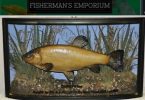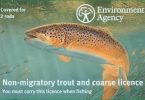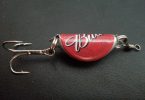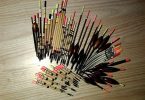Angling literature is full of old
wives’ tales that have been repeated so many times that they’re now accepted as
“fact”. In this piece, I intend highlighting some of these fishing fallacies. No
doubt some of these statements will be considered controversial, and I’m sure the Editor
will love you to write in and say so – but please keep replies factual rather than
abusive!
“A hook tied direct to the reel line is
stronger as there’s only one knot”
I’ve started with a simple one that’s been around for a long, long time
– and wrong for equally as long!
Naturally, all knots weaken the line, some more than others. However,
the correct answer is summed up by the old proverb “a chain is only as strong as its
weakest link”. In other words, whether you have 1 knot or 21, it’s the weakest that
determines the breaking strain of the line.
This fallacy may have arisen because the more knots you tie the greater
the chance of tying a bad one. However, if you stick to recognised knots such as the
grinner or palomar you can minimise such a risk.
“Perch feed best and grow biggest in clear
water”
If I had a pound for every time I’ve heard this one, I’d be a rich man!
The truth of the matter is that perch, like any fish, grow biggest where they can obtain
the maximum amount of food for the minimum amount of effort. This might be in clear water,
but it could equally well be in murky water. Indeed, the record perch came from Furnace
Pond in Kent, which is far from clear! This sort of cloudy lake often contains an
abundance of stunted fodder fish, and if a perch can easily fill its belly on small fry
its growth rate can be spectacular.
This particular fallacy about perch and clear water may have arisen
because scientists have established that perch are predominantly sight feeders and that
they have better eyesight than their prey. Anglers then wrongly assumed that clear water
improved the chances of perch getting a meal. This was compounded by Dick Walker’s catches
of specimen perch from crystal clear Arlesey Lake during the brightest part of winter
days. However, what many overlooked is that these perch were caught at great depth (about
40 feet), where even at midday the light in winter would be minimal.
In fact, my own experience suggests that perch feed best in dim light,
when they have the maximum advantage over their poorer sighted prey. At night neither can
see at all, but in bright conditions any attacking perch can more easily be spotted and
avoided. Certainly in nearly all the shallower waters I’ve fished, the best time to catch
big perch has been dusk and, to a lesser extent, dawn. However, I suspect that the
visibility would then be about the same as 40 feet down in Arlesly at midday. In fact,
this is a typical case of the wrong conclusion being drawn from observations, thus leading
to yet another old wives’ tale!
“Pike are out of condition before
October”
Traditionally, the pike season has opened on October 1st, which in many
areas corresponded with the end of the trout season. The reason given was that pike are
“out of condition” until then, and, of course, many clubs still prohibit summer
piking.
There may, just possibly, be a sensible reason for such a ban, but to
suggest that summer pike are out of condition is totally incorrect! In fact, pike are the
first coarse fish to spawn each year, which gives them a head start so that the young pike
have ample fry of other species on which to feed.
Pike take no longer to recover from spawning than other species and so,
by June 16th, they’re in excellent condition. Anyone who’s done any summer
piking will tell you that there’s just no comparison between the fight of pike in summer
compared with the colder months. Indeed my first double, an l8lber, was caught from Lomond
in between March snow showers and the fight was so feeble I was sure it was only a jack.
Contrast this with a seventeen pounder on the next trip in summer, which fought like a
tiger, tailwalked and drenched us with spray!
Having said that, there may be a case for banning summer piking, not
because the pike are out of condition but because they’re then so fit they fight too hard!
If the pike takes long to unhook when it’s exhausted from a prolonged fight and when
oxygen levels are low, it is somewhat less likely to survive. The solution is, of course,
education in unhooking pike, but on some fisheries there may be a case for restricting
summer piking to lures, which can quickly be removed in nearly every case. In any event,
if you do fish for pike in summer, do make doubly sure you return any pike as quickly as
possible with the minimum of photographs.
“Compound taper rods have through
actions”
This is one that even many tackle shops get wrong! A compound taper rod
is simply one with a taper that isn’t constant – it doesn’t tell you anything about the
action of the rod at all!
In fact, the action can be altered by varying the diameter, wall
thickness or material of the blank. This means that a compound taper rod will have a more
complex action, but may be either through or tip actioned. In practice most good rods have
a compound taper – even the tip-actioned models.
A further problem is that there’s no consistency as to what constitutes
a through action. True through action rods appear to have gone out of fashion. Indeed,
I’ve spoken to many anglers who claim that they use through action rods, yet often their
rods are almost as stiff as poles. Just because a rod has a soft tip doesn’t mean it’s
through- actioned!
I’d like to finish this answer by making a plea for some
standardisation. This way when someone recommends a type of rod or when you buy a rod, you
know what you’re getting. To my mind, rods can be divided into 3 actions -tip, medium and
through. A medium action means that the rod will bend to between 1/3 and 2/3 the length of
the rod. It may bend a little more in the butt, but most of the action will be higher up.
A tip action rod bends less than this, a through action rod bends more. An
oversimplification maybe, but infinitely better than the confusion we have at present!
“Barbless hooks do less damage”
This is only partly true, as scientific experiments in America have
shown. It certainly doesn’t apply when using large hooks for species like perch, which
have vital organs near the back of the throat. The problem is that barbless hooks
penetrate more deeply and large barbless hooks especially so. In fact, they may penetrate
so deeply that they can actually kill the fish. For this reason, I never use barbless
hooks in size 12 and above for perch. However, there’s no need for a large barb and a
micro-barb in these bigger hooks is a perfect compromise.
In smaller sizes, 14 downwards, I use a fully barbless hook and never
seem to have any problems. If the rules on the water that you are fishing insist on
barbless, show the owner these words and hopefully he won’t want to damage his valuable
fish. If he still won’t see sense, you’ll have to take a chance on barbless hooks and I’d
advise you to put a small piece of elastic band on the point of the hook, which goes part
of the way towards solving the problem.
Tight Lines,
Steve Burke








